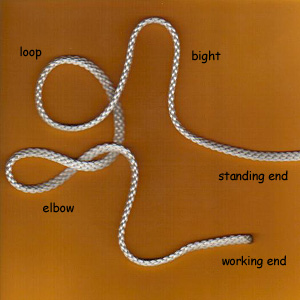The term knot is used generically to cover knots, hitches, and bends, we do that here in the Canebrake13 as well. Technically, knots, hitches and bends are structurally different and serve different purposes.
- Knot– The critical element in determining a knot is that when it is tied, it is self-contained and self-supporting in the rope that creates some other function. It does not need another object or rope to maintain the integrity of the knot.
- Hitch- Are used to fix a rope to another object. Without the object or other rope, it will fall apart. The other object or rope assists in maintaining its structure.
- Bend- Fastens two ropes together.
Knot Strength
Knots weaken the rope in which they are made. When knotted rope is strained to its breaking point, it almost always fails at the knot or close to it, unless it is defective or damaged elsewhere. The bending, crushing, and chafing forces that hold a knot in place also unevenly stress rope fibers and ultimately lead to a reduction in strength. Even if the rope does not break, a knot may still fail to hold. The main ways knots fail to hold are:
Slipping
The load creates tension that pulls the rope back through the knot in the direction of the load. If this continues far enough, the working end passes into the knot and the knot unravels and fails. This behavior can worsen when the knot is repeatedly strained and let slack, dragged over rough terrain, or repeatedly struck against hard objects.
Even with secure knots, slippage may occur when the knot is first put under real tension. This can be mitigated by leaving plenty of rope at the working end outside of the knot, and by dressing the knot cleanly and tightening it as much as possible before loading. The use of a stopper knot or a backup knot can prevent the working end from passing through the knot. If a knot is observed to slip, it is preferable to use a more secure knot.
Spilling
Spilling a knot refers to changing a knot's form and rearranging its parts, usually by pulling on specific ends in certain ways. When used incorrectly, some knots tend to capsize easily. Often the capsized form of the knot offers little resistance to slipping or unraveling. A Reef Knot, when misused as a bend, can capsize dangerously.
Sliding
In knots that are meant to grip other objects, failure can be defined as the knot moving relative to the gripped object. For instance, a simple Rolling Hitch tied around a railing and pulled parallel to the railing might hold up to a certain tension, then start sliding. Sometimes this problem can be corrected by working-up the knot tighter before subjecting it to load, but usually the problem requires either a knot with more wraps or a rope of different diameter or material.

